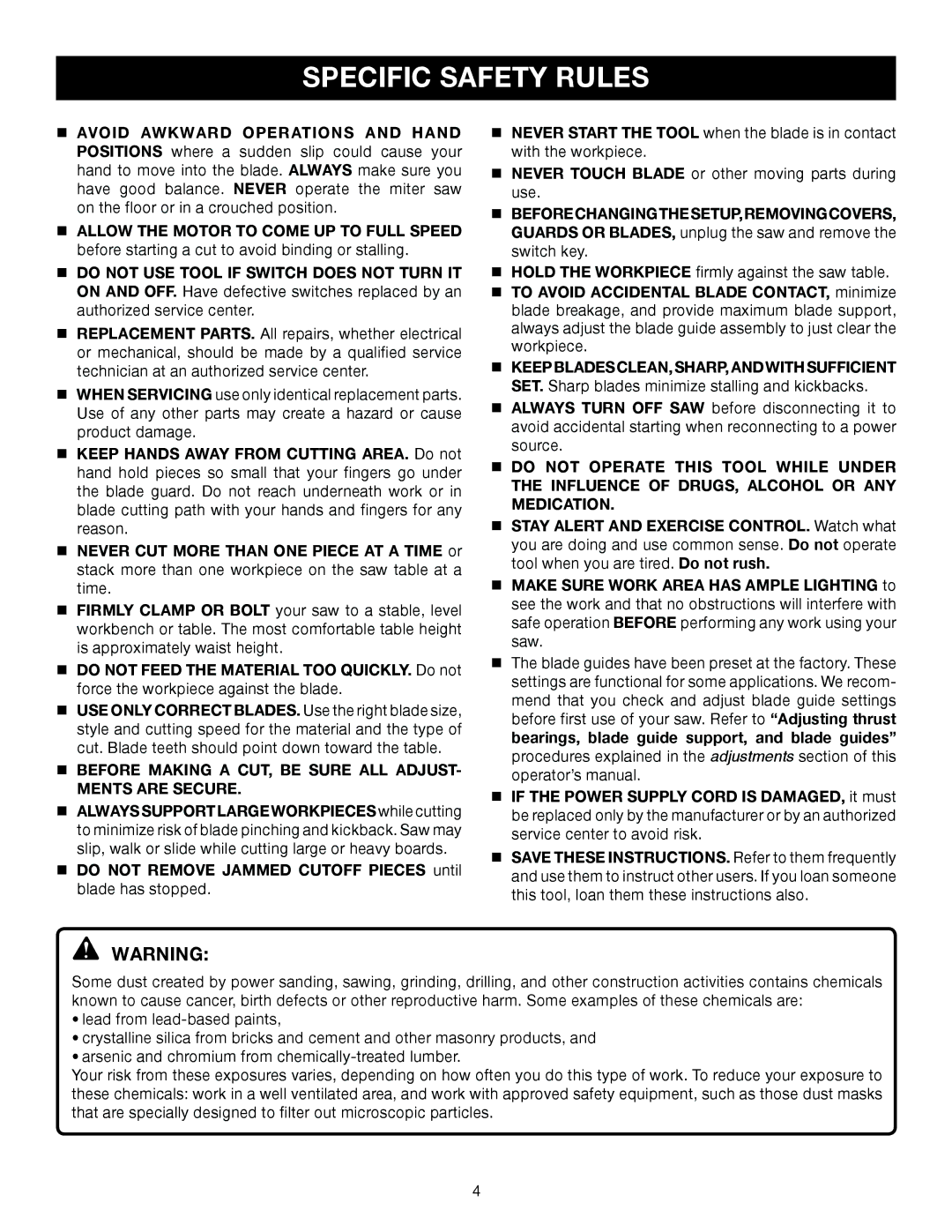
SPECIFIC SAFETY RULES
AVOID AWKWARD OPERATIONS AND HAND POSITIONS where a sudden slip could cause your hand to move into the blade. ALWAYS make sure you have good balance. NEVER operate the miter saw on the floor or in a crouched position.
ALLOW THE MOTOR TO COME UP TO FULL SPEED before starting a cut to avoid binding or stalling.
DO NOT USE TOOL IF SWITCH DOES NOT TURN IT ON AND OFF. Have defective switches replaced by an authorized service center.
REPLACEMENT PARTS. All repairs, whether electrical or mechanical, should be made by a qualified service technician at an authorized service center.
WHEN SERVICING use only identical replacement parts. Use of any other parts may create a hazard or cause product damage.
KEEP HANDS AWAY FROM CUTTING AREA. Do not hand hold pieces so small that your fingers go under the blade guard. Do not reach underneath work or in blade cutting path with your hands and fingers for any reason.
NEVER CUT MORE THAN ONE PIECE AT A TIME or stack more than one workpiece on the saw table at a time.
FIRMLY CLAMP OR BOLT your saw to a stable, level workbench or table. The most comfortable table height is approximately waist height.
DO NOT FEED THE MATERIAL TOO QUICKLY. Do not force the workpiece against the blade.
USE ONLY CORRECT BLADES. Use the right blade size, style and cutting speed for the material and the type of cut. Blade teeth should point down toward the table.
BEFORE MAKING A CUT, BE SURE ALL ADJUST- MENTS ARE SECURE.
ALWAYS SUPPORT LARGE WORKPIECES while cutting to minimize risk of blade pinching and kickback. Saw may slip, walk or slide while cutting large or heavy boards.
DO NOT REMOVE JAMMED CUTOFF PIECES until blade has stopped.
NEVER START THE TOOL when the blade is in contact with the workpiece.
NEVER TOUCH BLADE or other moving parts during use.
BEFORECHANGINGTHESETUP,REMOVINGCOVERS, GUARDS OR BLADES, unplug the saw and remove the switch key.
HOLD THE WORKPIECE firmly against the saw table.
TO AVOID ACCIDENTAL BLADE CONTACT, minimize blade breakage, and provide maximum blade support, always adjust the blade guide assembly to just clear the workpiece.
KEEPBLADESCLEAN,SHARP,ANDWITHSUFFICIENT SET. Sharp blades minimize stalling and kickbacks.
ALWAYS TURN OFF SAW before disconnecting it to avoid accidental starting when reconnecting to a power source.
DO NOT OPERATE THIS TOOL WHILE UNDER THE INFLUENCE OF DRUGS, ALCOHOL OR ANY MEDICATION.
STAY ALERT AND EXERCISE CONTROL. Watch what you are doing and use common sense. Do not operate tool when you are tired. Do not rush.
MAKE SURE WORK AREA HAS AMPLE LIGHTING to see the work and that no obstructions will interfere with safe operation BEFORE performing any work using your saw.
The blade guides have been preset at the factory. These settings are functional for some applications. We recom- mend that you check and adjust blade guide settings before first use of your saw. Refer to “Adjusting thrust bearings, blade guide support, and blade guides” procedures explained in the adjustments section of this operator’s manual.
IF THE POWER SUPPLY CORD IS DAMAGED, it must be replaced only by the manufacturer or by an authorized service center to avoid risk.
SAVE THESE INSTRUCTIONS. Refer to them frequently and use them to instruct other users. If you loan someone this tool, loan them these instructions also.
WARNING:
Some dust created by power sanding, sawing, grinding, drilling, and other construction activities contains chemicals known to cause cancer, birth defects or other reproductive harm. Some examples of these chemicals are:
•lead from
•crystalline silica from bricks and cement and other masonry products, and
•arsenic and chromium from
Your risk from these exposures varies, depending on how often you do this type of work. To reduce your exposure to these chemicals: work in a well ventilated area, and work with approved safety equipment, such as those dust masks that are specially designed to filter out microscopic particles.
4
